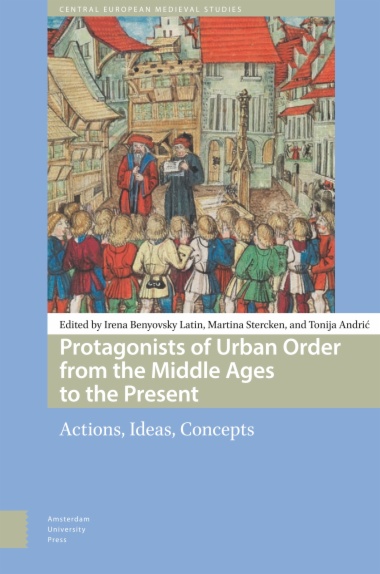European cities and towns are considered places with a particular order established by their inhabitants. This volume centres on the authorities, groups, and individuals who formed the rules for common life in urban communities. It considers the protagonists of urban order between the Middle Ages and modernity: those who were responsible for the common welfare, those who produced change, and those who caused disorder. The authors focus on the practices that shaped the order of urban communities and in particular on situations in which this order was transformed socially and spatially. By looking at urban order through this lens, the volume sheds light on the complex interplay of interests that can bring about change.
- Cover
- Table of Contents
- About the Volume
- Introduction: Protagonists of Urban Order in Pre-modern Times
- I. Representing Urban Order
- 1. Traditional and New Ways of Dubrovnik’s Noble Elite to Maintain Urban Order in the Fourteenth Century
- 2. Guardians of Urban Order? Autocratic Mayors in the Late Middle Ages: The Case of Hans Waldmann
- 3. Magistrates of the Venetian Republic as Decision-makers and Executors Welcoming Foreigners to the City (Fifteenth–Sixteenth Centuries)
- II. Transforming Spatial Order
- 4. Mythologizing Cities and Kings: The Wessex burhs of King Alfred the Great
- 5. Spatial Order and City Authorities in Thirteenth-Century Bologna
- 6. The Role of Female Monasteries in the Organization of Urban Spaces in Southern Italian Cities: The Case of Matera
- 7. Urban Community and the Common Good Control over the Building Activities and Water Management in Southern Italy (Thirteenth–Fourteenth Centuries)
- III. Changing Social Order
- 8. Plague and the Social Order in Early Modern Italy: Tuscany, 1630–1633
- 9. Civil Society and Urban Order: Suggestions and Questions
- 10. Urban Order in the Early Years of Narvik (1902–1910)
- IV. Protagonists of Urban Order in a Diachronic Perspective
- 11. Protagonists of Urban Spatial Order in a Longue Durée Perspective: Example of the City of Luxembourg
- 12. From Medieval Principality to Modern State: The Impact of Change on Towns in the Romanian Area
- 13. Perceptions of Urban Poverty and Good Polity in Denmark from the Black Death to 2021
- Index of Names
- Index of Places
- List of Figures and Tables
- Figures
- Figure 2.1. The Höngg Report (Der Höngger Bericht), probably 1489, p. 25 (cf. n. 34).
- Figure 2.2. Diebold Schilling’s Lucerne Chronicle of 1513, p. 299. Source: Luzern, Korporation Luzern, S 23 fol.: https://www.e-codices.unifr.ch/de/description/kol/S0023-2/Kamber.
- Figure 2.3. Johannes Stumpf, Chronicle of the Swiss Confederacy. Source: Johannes Stumpf, Gemeiner loblicher Eydgnoschafft Stetten, Landen und Völckeren Chronick wirdiger Thaaten beschreybung (Zurich, 1548), bk 6, fol. 162 (Zentralbibliothek Zürich AW 40:
- Figure 2.4. Hans Waldmann’s gravestone, Fraumünster, Zurich. Source: Public domain.
- Figure 4.1. Statue of King Alfred, Winchester (Hampshire, UK). Photograph (1901–10). Source: Library of Congress, reproduction number: LC-DIG-ppmsca-52447 (digital file from original item) LC-USZ62-113137 (b&w film copy neg.), https://www.loc.gov/item/955
- Figure 4.2. Geographical distribution of burhs in the kingdom of Wessex. Map: Keith D. Lilley.
- Figure 4.3. Layout of Alfred’s Winchester (map orientated north). Source: Martin Biddle and Derek Keene, eds, The British Historic Towns Atlas, Vol. VI: Winchester (Oxford: The Historic Towns Trust and the Winchester Archaeological Committee, 2017).
- Figure 4.4. Plans of Wessex burhs compared: Wareham (Dorset) and Cricklade (Wiltshire). Map: Keith D. Lilley.
- Figure 4.5. Assumed layout of the burh of Hereford (map orientated north). Source: M. D. Lobel, ed., Historic Towns: Maps and Plans of Towns and Cities in the British Isles, with Historical Commentaries, from Earliest Times to circa 1800, Volume I (Oxford
- Figure 4.6. Assumed layout of the burh of Oxford (map orientated north). Source: Alan Crossley, ed., The British Historic Towns Atlas, Vol. VII: Oxford (Oxford: Historic Towns Trust, 2021).
- Figure 4.7. Plan of medieval Chester. The Anglo-Saxon burh occupied an area formed by the cross of streets within East Gate (numbered 24 on the plan), North Gate (26), Holy Trinity church (6), and St Michael’s church (11). The position of churches at gate
- Figure 6.1. View of Matera. Source: Google.
- Figure 6.2. S. Lucia alle Malve. Photo: R. Paolicelli, Archivio Antros.
- Figure 6.3. S. Lucia allo Sperone. Photo: R. Paolicelli, Archivio Antros.
- Figure 6.4. S. Lucia al Piano. Photo: R. Paolicelli, Archivio Antros.
- Figure 6.5. S. Maria la Nova/S. Giovanni. Photo: F. Panarelli.
- Figure 6.6. SS. Annunziata (former S. Maria La Nova). Photo: R. Paolicelli, Archivio Antros.
- Figure 7.1. A theoretical exercise in land allotment by Fra’ Giocondo da Verona (1433–1515), architectus nobilis: ‘How many houses of 20 x 30 feet can we build in a round city with a circumference of 8,000 feet?’ Source: Florence, Bibl. Mediceo-laurenzian
- Figure 7.2. The Statutes of Sassari (1294–1316, I, XXXVIII, De non impazare sas vias [Do not clutter the streets]) defines in detail a façade model characterized by progressive overhangs of the attic on each floor, determining its measurements in palms.
- Figure 7.3. Sassari, the Fontana del Rosello, formerly under the control of the Partidores de Abba, nine officials responsible for the distribution of water across vast peri-urban horticultural areas, as stipulated by the Statutes of 1316. Photo: Marco Ca
- Figure 7.4. Aidomaggiore, near Oristano, distribution of water for public use. A fountain is depicted in the foreground, then the drinking trough for animals, and, in the background, a covered wash house. Even further in the background are the vegetable g
- Figure 11.1. City map by Jacob van Deventer, around 1561 (orientated to the north). Source: Koninklijke Bibliotheek van België, Ms. 22.090 (50).
- Figure 11.2. City map by Erasmy from 1868 with the planned arterial roads (orientated to the north). Source: Archives nationales du Luxembourg, P-551.
- Figure 11.3. City map by Junck from 1936 with the new city districts (orientated to the north). Source: Lëtzebuerg City Museum, nr. 1993.148.
- Figure 11.4. Kirchberg development plan (orientated to the north). Source: © Fonds Kirchberg/Gehl architects (2019).
- Tables
- Table 10.1. Arrests in Rombaksbotn and Narvik, 1900–1914. Source: State Archives.
- Table 10.2. Arrests Due to Drunkenness in Narvik and Bodø, 1896–1915. Source: State Archives.
- Table 10.3. Cases Handled by the Child Protection Council in Narvik and Bodø, 1904–11. Source: NOS, V. 51; NOS, V. 96; NOS, V. 164; NOS, VI. 15.
- Table 10.4. Children under Surveillance by the Child Protection Council in Narvik and Bodø, 1904–11. Source: NOS, V. 51; NOS, V. 96; NOS, V. 164; NOS, VI. 15.

